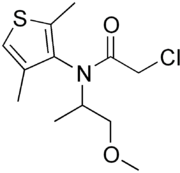- Dimethenamid
-
Dimethenamid[1][2]  (RS)-2-Chloro-N-(2,4-dimethyl-3-thienyl)-N-(2-methoxy-1-methylethyl)acetamideOther names
(RS)-2-Chloro-N-(2,4-dimethyl-3-thienyl)-N-(2-methoxy-1-methylethyl)acetamideOther namesIdentifiers CAS number 87674-68-8 PubChem 91744 ChemSpider 82842 
KEGG C18499 
RTECS number AB5444200 Jmol-3D images Image 1
Image 2- CC1=CSC(=C1N(C(C)COC)C(=O)CCl)C
ClCC(=O)N(c1c(scc1C)C)C(COC)C
Properties Molecular formula C12H18ClNO2S Molar mass 275.79 g/mol Appearance Tan to brown liquid Density 1.141 g/cm3 Hazards MSDS MSDS from BASF R-phrases R22 Main hazards Xn (harmful) Flash point 151 °C  (verify) (what is:
(verify) (what is:  /
/ ?)
?)
Except where noted otherwise, data are given for materials in their standard state (at 25 °C, 100 kPa)Infobox references Dimethenamid is a widely used herbicide. In 2001, about 7 million pounds of dimethenamid were used in the United States.[4]
References
- ^ Dimethenamid at Sigma-Aldrich
- ^ Material Safety Data Sheet from BASF
- ^ Dimethenamid at AlanWood.net
- ^ 2000-2001 Pesticide Market Estimates, U.S. Environmental Protection Agency
Pest control: herbicides Anilides/Anilines acetochlor · alachlor · asulam · butachlor · diethatyl · diflufenican · dimethenamid · flamprop · metazachlor · metolachlor · pendimethalin · pretilachlor · propachlor · propanil · trifluralinAromatic acids Arsenicals Organophosphorus Phenoxy Pyridines Quaternary Triazines ametryn · atrazine · cyanazine · hexazinone · prometon · prometryn · propazine · simazine · simetryn · terbuthylazine · terbutrynUreas Others 3-AT · bromoxynil · clomazone · DCBN · dinoseb · juglone · mesotrione · methazole · metham sodium · sulfentrazone
This article about an organic compound is a stub. You can help Wikipedia by expanding it. - CC1=CSC(=C1N(C(C)COC)C(=O)CCl)C
